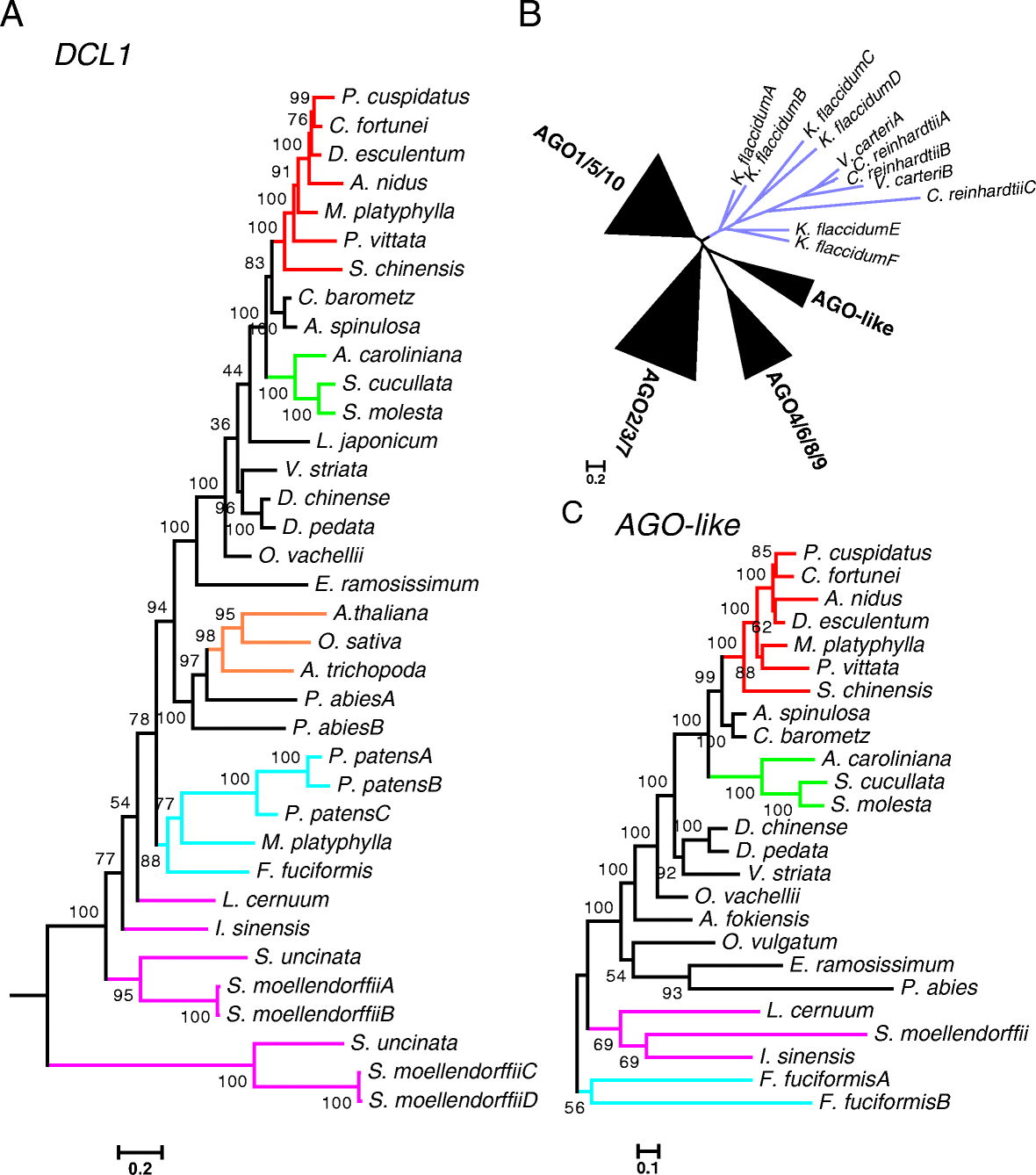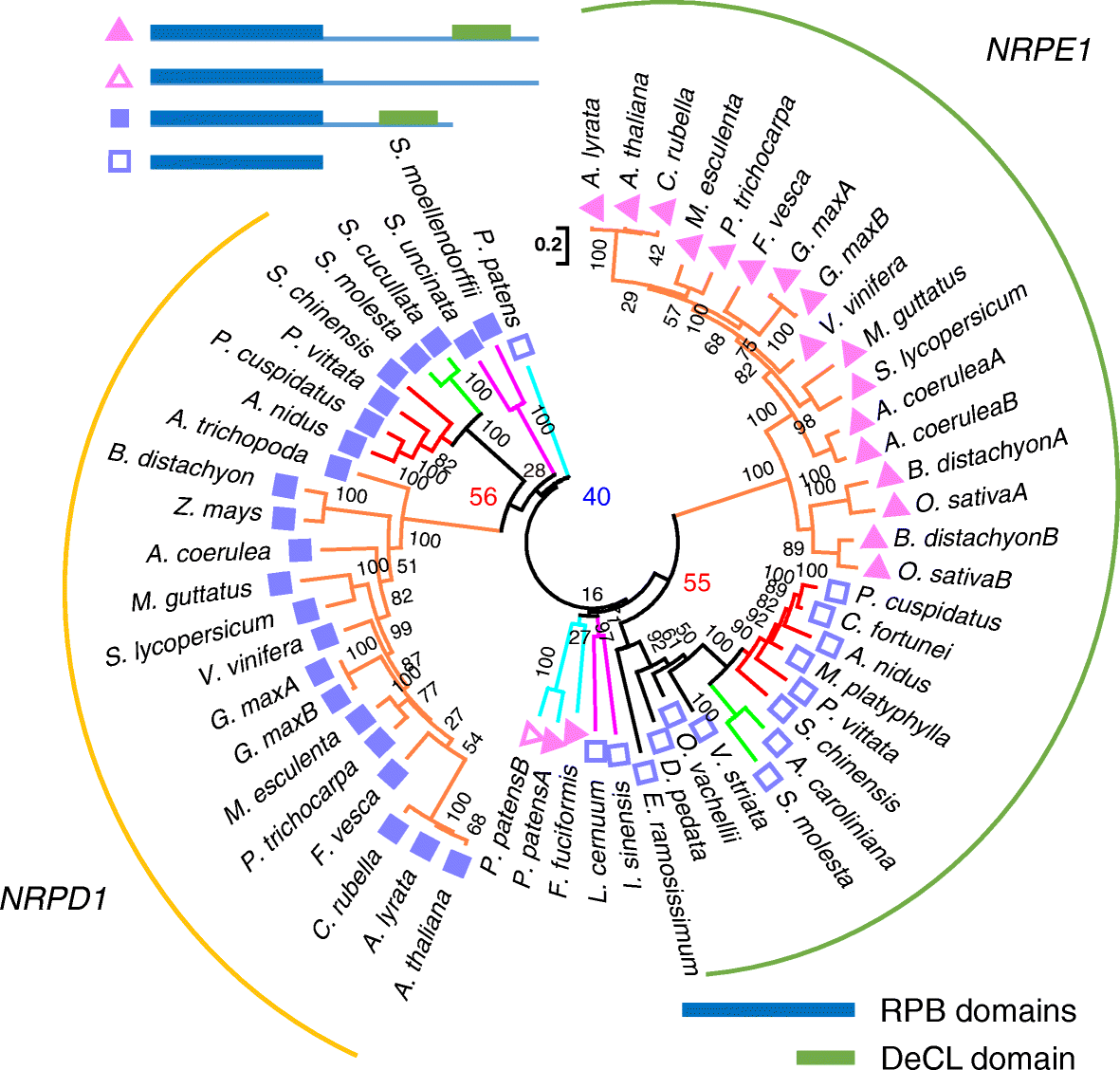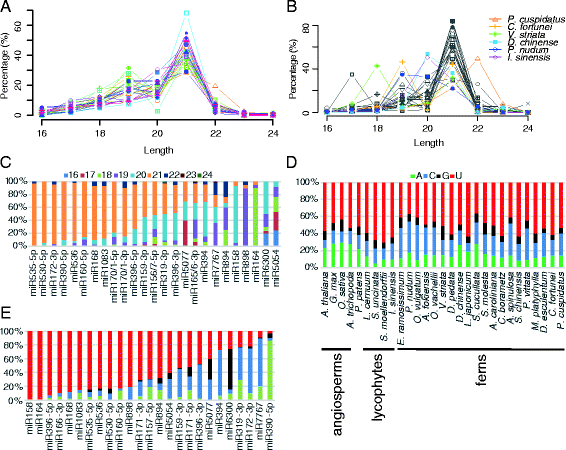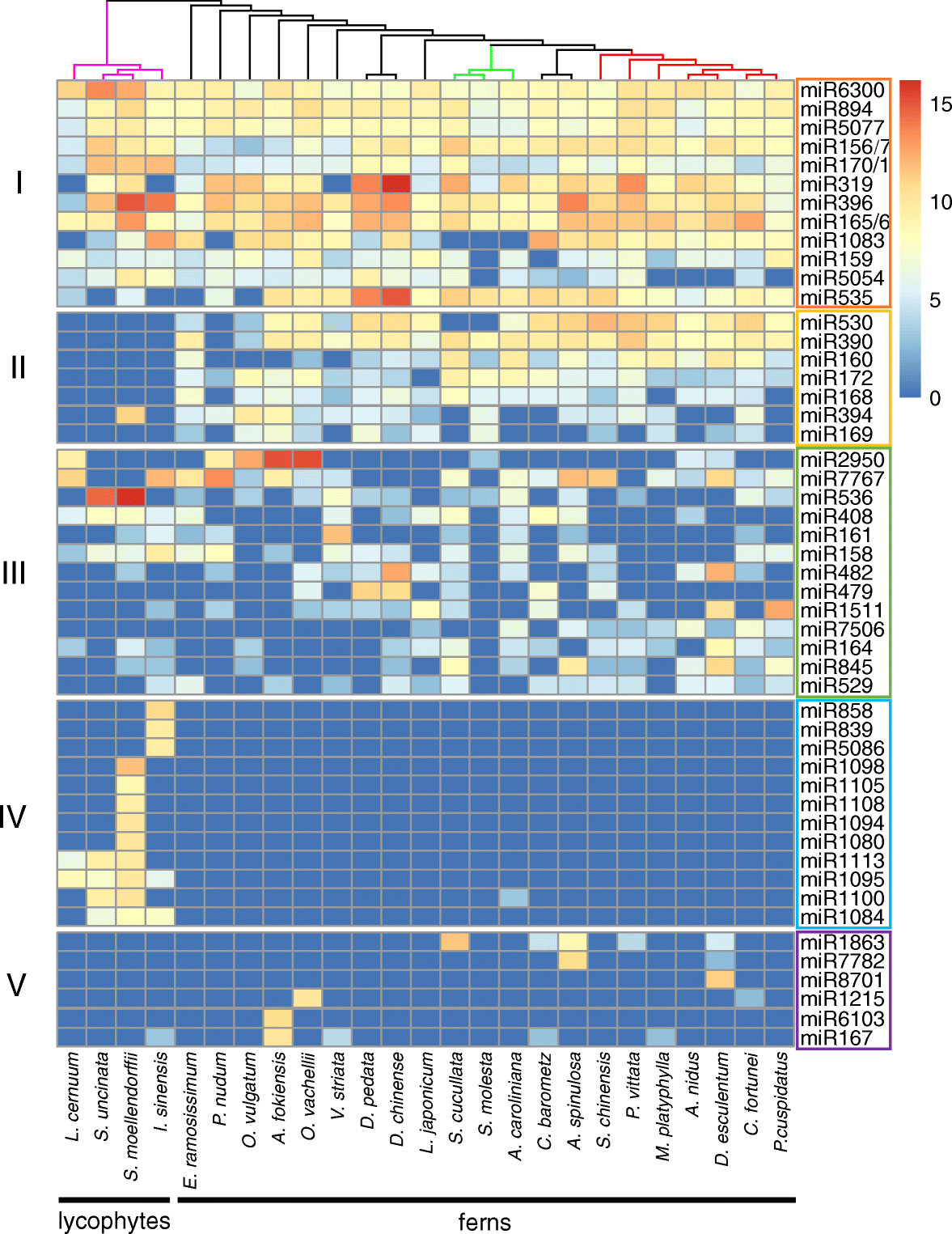Conservation and divergence of small RNA pathways and microRNAs in land plants
- PMID: 28835265
- PMCID: PMC5569507
- DOI: 10.1186/s13059-017-1291-2
Conservation and divergence of small RNA pathways and microRNAs in land plants
Abstract
Background: As key regulators of gene expression in eukaryotes, small RNAs have been characterized in many seed plants, and pathways for their biogenesis, degradation, and action have been defined in model angiosperms. However, both small RNAs themselves and small RNA pathways are not well characterized in other land plants such as lycophytes and ferns, preventing a comprehensive evolutionary perspective on small RNAs in land plants.
Results: Using 25 representatives from major lineages of lycophytes and ferns, most of which lack sequenced genomes, we characterized small RNAs and small RNA pathways in these plants. We identified homologs of DICER-LIKE (DCL), ARGONAUTE (AGO), and other genes involved in small RNA pathways, predicted over 2600 conserved microRNA (miRNA) candidates, and performed phylogenetic analyses on small RNA pathways as well as miRNAs. Pathways underlying miRNA biogenesis, degradation, and activity were established in the common ancestor of land plants, but the 24-nucleotide siRNA pathway that guides DNA methylation is incomplete in sister species of seed plants, especially lycophytes. We show that the functional diversification of key gene families such as DCL and AGO as observed in angiosperms occurred early in land plants followed by parallel expansion of the AGO family in ferns and angiosperms. We uncovered a conserved AGO subfamily absent in angiosperms.
Conclusions: Our phylogenetic analyses of miRNAs in bryophytes, lycophytes, ferns, and angiosperms refine the time-of-origin for conserved miRNA families as well as small RNA machinery in land plants.
Keywords: Argonaute; DICER-LIKE; Evolution; Fern; Lycophyte; RdDM; Small RNA; miRNA.
Conflict of interest statement
Ethics approval and consent to participate
Not applicable.
Consent for publication
Not applicable.
Competing interests
The authors declare that they have no competing interests.
Publisher’s Note
Springer Nature remains neutral with regard to jurisdictional claims in published maps and institutional affiliations.
Figures








Similar articles
-
Sequencing of small RNAs of the fern Pleopeltis minima (Polypodiaceae) offers insight into the evolution of the microrna repertoire in land plants.PLoS One. 2017 May 11;12(5):e0177573. doi: 10.1371/journal.pone.0177573. eCollection 2017. PLoS One. 2017. PMID: 28494025 Free PMC article.
-
Angiosperms Are Unique among Land Plant Lineages in the Occurrence of Key Genes in the RNA-Directed DNA Methylation (RdDM) Pathway.Genome Biol Evol. 2015 Sep 2;7(9):2648-62. doi: 10.1093/gbe/evv171. Genome Biol Evol. 2015. PMID: 26338185 Free PMC article.
-
Conservation and diversification of HAIRY MERISTEM gene family in land plants.Plant J. 2021 Apr;106(2):366-378. doi: 10.1111/tpj.15169. Epub 2021 Mar 27. Plant J. 2021. PMID: 33484592
-
What can lycophytes teach us about plant evolution and development? Modern perspectives on an ancient lineage.Evol Dev. 2021 May;23(3):174-196. doi: 10.1111/ede.12350. Epub 2020 Sep 9. Evol Dev. 2021. PMID: 32906211 Review.
-
Conservation and divergence in plant microRNAs.Plant Mol Biol. 2012 Sep;80(1):3-16. doi: 10.1007/s11103-011-9829-2. Epub 2011 Oct 14. Plant Mol Biol. 2012. PMID: 21996939 Review.
Cited by
-
Further Elucidation of the Argonaute and Dicer Protein Families in the Model Grass Species Brachypodium distachyon.Front Plant Sci. 2019 Oct 22;10:1332. doi: 10.3389/fpls.2019.01332. eCollection 2019. Front Plant Sci. 2019. PMID: 31708948 Free PMC article.
-
Genomic insights into genetic diploidization in the homosporous fern Adiantum nelumboides.Genome Biol Evol. 2022 Aug 10;14(8):evac127. doi: 10.1093/gbe/evac127. Online ahead of print. Genome Biol Evol. 2022. PMID: 35946426 Free PMC article.
-
The Arabidopsis thaliana F-box gene HAWAIIAN SKIRT is a new player in the microRNA pathway.PLoS One. 2017 Dec 15;12(12):e0189788. doi: 10.1371/journal.pone.0189788. eCollection 2017. PLoS One. 2017. PMID: 29244865 Free PMC article.
-
Genome-wide analyses across Viridiplantae reveal the origin and diversification of small RNA pathway-related genes.Commun Biol. 2021 Mar 25;4(1):412. doi: 10.1038/s42003-021-01933-5. Commun Biol. 2021. PMID: 33767367 Free PMC article.
-
Atypical DNA methylation, sRNA-size distribution, and female gametogenesis in Utricularia gibba.Sci Rep. 2021 Aug 3;11(1):15725. doi: 10.1038/s41598-021-95054-y. Sci Rep. 2021. PMID: 34344949 Free PMC article.
References
Publication types
MeSH terms
Substances
Grants and funding
LinkOut - more resources
Full Text Sources
Other Literature Sources
Molecular Biology Databases
Research Materials

